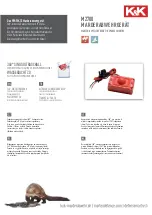
GB
3
2.3) Phototest
The TCE makes it possible to utilise the test function some of the
automation control units have. The “normal” state is when the “Pho-
totest” input is live, while the “Test” state is activated by disconnect-
ing the power supply from the input, as shown in Figure 3.
The TCE “Phototest” input (Terminals 8-9) must be connected to the
phototest output of the automation control unit. Refer to the relative
instructions if necessary.
If the control unit does not have this “Test” or the user does not wish
to utilise it, then the phototest input must be connected up to the
TCE power supply, as shown in Figure 4.
Technical note: The “Phototest” input can be powered using either
alternating or direct current, and there is no need to respect any kind
of polarity. However, in some control units, this could cause the
incorrect execution of the phototest. If this should occur, after hav-
ing checked that the connections are correct, cut the track under the
printed circuit as shown in Figure 5 and try again. If the problem pre-
sents again, invert the phototest wires (Terminals 8–9), too. The cut
track can be restored at any time, simply by soldering the two bump
contacts.
Phototest: V
Normal
Test
Normal
3
POWER SUPPLY
12-28Vac 50/60Hz 12-30Vdc
9
7
6
8
11
10
INPUT 8,2K
Ω
4
4
2.1) Electrical connections
Figure 2 shows a typical TCE wiring diagram. Follow these instruc-
tions carefully when making electrical connections.
• Refer to the “Technical Features” chapter in order to check the
suitability of the TCE in terms of supply voltage, performance of the
output relay contacts, and the maximum cable length.
• The source of the power supply must be suitably insulated from
the mains by means of insulation transformers which conform with
EN 61558, or equivalent insulation. The power supply and output
contacts of the TCE must be protected against short-circuiting.
• Use wires with a minimum cross-section of 0.25mm
2
.
• Do not connect cables in buried boxes, even if they are complete-
ly watertight.
• If there is more than one device with NC contacts for the same
input of the control unit, they must be connected in “SERIES”.
2.2) Description of the connections
Here follows a brief description of the TCE connections to the electro-sensitive device and automation control unit:
12
3
4
5
67
8
9
10
11
Led 1
Led 2
COMMON
NC Stop
NO (optional)
COMMON
NC PHOTO
+
-
POWER SUPPLY
12-28Vac 50/60Hz 12-30Vdc
PHOTOTEST
12-28Vac 50/60Hz 12-30Vdc
INPUT 8,2K
Ω
2
Terminals
FUNCTION
Description
1-2
OUT1
Output no. 1 with NC contact, immediate triggering
4-5
OUT2
Output no. 2 with NC contact, delayed triggering
6-7
Power supply
12-24Vac/dc Power supply
8-9
Phototest Test
input
10-11
8.2k
Ω
8.2k
Ω
sensitive device input.



































